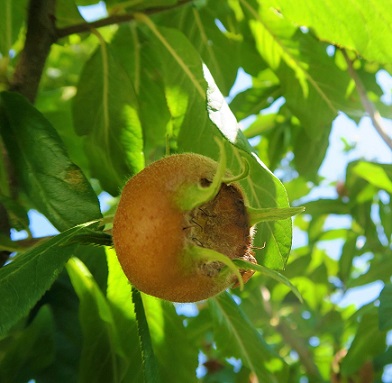In a world where modern agriculture has brought an abundance of fruits and vegetables to our tables, it’s easy to overlook the treasures of the past. Ancient fruits, once cherished by our ancestors, are making a remarkable comeback, captivating the taste buds of the curious and the adventurous. Among these enigmatic rediscoveries, the medlar stands out as a fruit of both historical significance and unique flavor.
A Glimpse into the Past
The medlar (Mespilus germanica) is a fruit that traces its roots back to ancient times. It was beloved by the Greeks and Romans, who cultivated it extensively in their orchards. Shakespeare even mentioned medlars in his writing, referring to them as “open-arse,” a playful nod to their unique appearance when ripe. However, despite its historical prominence, the medlar gradually faded into obscurity as other fruits gained favor.
At first glance, the medlar may appear unassuming, almost alien. It’s a small, round fruit with a brownish skin that might lead one to think it’s overripe or spoiled. However, don’t be fooled by its appearance, for within lies a fascinating blend of flavors waiting to be discovered.
Unlocking the Medlar’s Flavor
The taste is a journey of contrasts. When fully ripe, it offers a sweetness reminiscent of dates or honey, providing a delightful, natural indulgence. As it matures, the tartness subsides, making way for its sugary core. Some adventurous palates even detect hints of spices like cinnamon and cloves, adding a layer of complexity to its profile. Its pleasant, floral aroma enhances the overall experience, making it a truly unique fruit.
The resurgence of interest in ancient fruits has paved the way for the medlar’s return to our plates. In recent years, food enthusiasts and chefs have embraced this forgotten gem, incorporating it into a variety of culinary creations. From jams and jellies to pies and desserts, the medlar’s complex flavor profile has found its way into modern kitchens.
Nutritional Value and Health Benefits
Beyond its enticing taste, the medlar offers nutritional benefits that make it a worthy addition to your diet. It’s a good source of dietary fiber, vitamins, and minerals, including vitamin C and potassium. The natural sweetness means you can indulge your sweet tooth without the guilt, and the fiber content supports digestive health.
Sourcing Medlars
Finding fresh medlar fruit can be a bit of a treasure hunt. While it’s not as common as other fruits in the market, you can explore various avenues to source them. Some specialty markets, particularly those focusing on European or unique fruits, might carry fresh medlar when in season. Farmer’s markets can also be a good place to inquire, as local farmers with medlar trees occasionally sell the fruit. For a more convenient option, some online specialty retailers offer the fruit, which they can deliver to your doorstep.
Growing Your Own Medlar Tree
For those who want a consistent supply of medlar fruit, consider growing your own medlar tree. These hardy trees can be cultivated in various parts of the United States, depending on the variety and local climate. With a little patience and care, you can enjoy the pleasure of harvesting your medlar fruit.
Rediscovering ancient fruits like the medlar is a delightful journey into the past and a testament to the resilience of nature’s bounty. Its unique flavor, historical significance, and nutritional value make it a remarkable addition to our modern palate. So, whether you find medlars at your local market or decide to plant your medlar tree, embrace the opportunity to savor this forgotten treasure and rekindle the connection to our culinary heritage. In doing so, you may discover a newfound appreciation for the fruits that time almost forgot.
